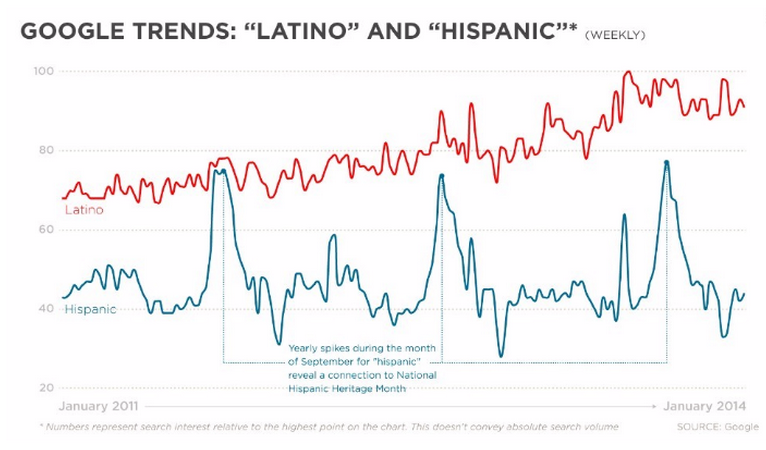Eric Wilbanks is a second-year Masters student at North Carolina State University. He does research on corpus and network data from social media and Spanish linguistics, among other things.
As the nation gears up for another presidential election season, increased media coverage and attention is given to important “minority” voting groups, as candidates scramble to cater to populations which are (at the moment) extremely important to them—or at least to their vote. As presidential hopeful Marco Rubio demonstrates, the Latino/Hispanic vote is one of these desirable minority votes and Republicans and Democrats alike are attempting to demonstrate their dedication to and affinity with Latino Culture and Issues. In doing so, these cultural “outsiders” struggle to “correctly” define their target audience; are they chasing the Latino vote? The Hispanic vote? The Mexican vote? People place a great deal of importance on defining people in terms of their ethnicity or cultural heritage, often using these labels to delineate the boundaries between groups or place individuals into pre-determined boxes.
Grouping people by labels can be problematic, though, and definitions of ethnic or cultural identity are particularly personal and often touchy subjects. For Latinos/Hispanics in the US, the question is particularly difficult because the group defined by these singular labels is nearly 54 million individuals from diverse countries of origin, spanning four continents and numerous cultures, dialects, and languages. How can we possibly hope to represent the vast diversity of this group under a single, catch-all label? The majority of Latinos in the US prefer to answer questions of “where are you from?” or “what’s your ethnicity?” with their or their parents’ country of origin. Responses of “I’m Puerto-Rican”, “My family is from Belize”, or “I’m Dominican-American” are incredibly common and acknowledge the vast geographic and cultural divides which define this “group.” Additionally, this strategy allows for self-definition and acknowledges the fact that many people who outsiders would consider Hispanic really define themselves as American and don’t usually have a strong connection to their cultural/ethnic heritage in their daily lives. For some Latino/Hispanic groups, their preferred self-identification is Indigenous. As one indigenous Mexican woman declares, “I’m not Latina. Latino means genocide for my people […] I’m indigenous.” For many people, terms like Latino (originally referencing countries ruled by the Roman Empire) or Hispanic (referencing territories colonized by Spain) bring to mind the horrible genocides carried out in the Americas and are absolutely inappropriate for self-labeling.
For many in the US, however, Hispanic or Latino are the preferred terms. As Soledad O’Brien, a CNN correspondent, notes, there was once a strong regional preference, with the West coast leaning more towards Latino and the East coast towards Hispanic. However, this distinction has dissipated in recent years. For some, Hispanic brings to mind a sense of artificial “pc-ness” or a formal flavor. In addition to being an English word, the term Hispanic brings to mind a direct connection with imperial Spain, again problematizing the diversity within the group. One young Latino youtube commentator says that for him personally, Hispanic “sounds very academic, technical, it doesn’t really roll o the tongue, hi-spa-nic, plus it gave us the racial slur. On the other hand Latino [clear /l/, Spanish vowels] rolls off the tongue a lot easier, it’s in Spanish which is the language that most of us speak and overall I just think it sounds a lot cooler.”
In terms of his place in wider trends, it seems that this youtube commentator is right on the money. In the above graphic from CNN, we see that in Google trends, Latino is experiencing a steady rise while Hispanic is remaining relatively low, with annual spikes around National Hispanic Heritage Month. As an interesting side note, with the rise in popularity of Latino in recent years, some scholars have attempted to introduce the replacement Latin@. This orthographic innovation plays on the fact that Spanish marks grammatical gender, with Latino referring to a male or neutral entity and Latina referring to a specifically female entity. With the use of the at sign, these scholars hope to reduce female invisibility and promote gender equity. Unfortunately, there’s no natural way to pronounce the at sign and for now Latin@ remains restricted to academic writing.
When considering what label to use for Latino/Hispanic/Indigenous/Latin@/Dominican/etc… individuals, you might be confused at first. While Hispanic is viewed as a “PC” term, many Latinos view the term as inauthentic and foreign or reminiscent of their bloody colonial history. Latino might be seen as a more general term, but again many individuals disagree with the European centric view the term imposes and prefer instead Indigenous, country of origin, or simply American. Attempting to classify groups using a single overarching label will be bound to lead you into trouble. Obsessing over an individual’s ethnicity or cultural heritage ignores the fact that people are more than just their history and they define themselves in different ways in different contexts. While the search for the most “appropriate” terminology is important for census data or other similar applications, in everyday life the most personable and equitable way to determine a person’s preferred label is simply to ask them.


